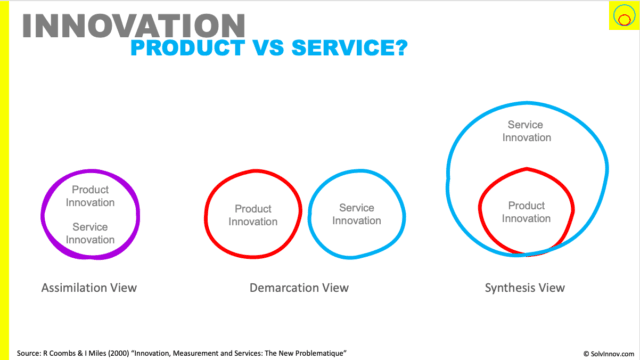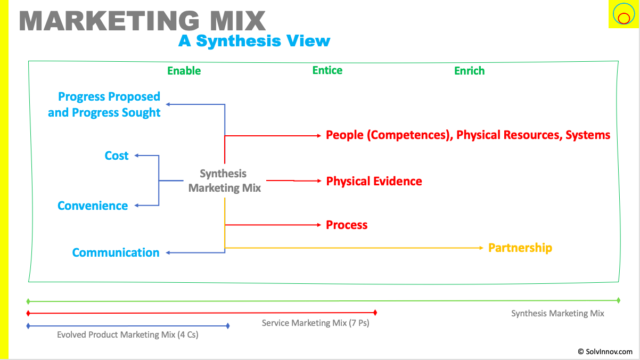The Big Picture…
In goods-dominant logic – our currently normal interpretation of the world – we define services in contrast to goods. And that leads to negative interpretation. Goods are good, services bad (or at best, problematic).
Firstly, services are intangible, inconsistent, inseparable, require the involvement of the customer; and you can’t create an inventory These are known as the 5Is of service (previously IHIP). And secondly, we complain that we have to extend the marketing mix to cope with services.
But is this tarring of service justified and correct? Not really. And I’ll summarise two papers in this article to highlight this:
- Lovelock & Gummerson show that not all services “suffer” from all the 5Is (“Whither Services Marketing”)
- Lush & Vargo show that these negative 5Is attributes should be benefits (“The Four Service Marketing Myths“)
Intangibility powers scalability, inconsistency should be seen as customisation. Lack of inventory reduces costs and enables the transfer of value creation from point of exchange to the point(s) of use. And inseparability/involvement leads to the benefit of co-creation of value.
As for the marketing mix, we should see it the other way around. That there is a fuller marketing mix than the goods view of product, price, promotion and place; but that for certain goods/services, not all aspects of the full marketing mix are important.
The “problem” with Service…
From the view of a goods-dominated world, service is a problem.
We can naturally get a handle on goods – tangible objects such as books, cars, buildings etc. And even stretch the concept to some intangibles that were previously tangibles. For example digital goods like MP3 songs or eBooks you read on a Kindle.
But services are a little harder to define if we start from a world where we first think of products.
And so, back in the ’80s when researchers started taking a deeper look at services, it was natural to describe services in terms of how they are different from goods.
Zeithmal, Parasuraman and Berr’s “Problems and Strategies in Service Marketing” summarises much of that work. And you can already see in that title the notion that services are problematic. Notably, they cemented the in everyone’s minds the unique features of services that gained the acronym IHIP. Services forever after became known as having intangibility, heterogeneity, inseparability and perishability (the definitions of which you can see in Figure 1).
These definitions are loaded with negativity. From the naming of the features – intangible, inseparable, perishable. Through the fact that they result in marketing problems. And onto the definitions of those marketing problems – lots of cannot, difficult etc.
The 5Is of Service
Later IHIP has evolved to be the 5Is of services, namely that services:
- by their nature are intangible and inconsistent
- where delivery and consumption are inseparable and require customer involvement
- and you cannot create an inventory.
But this doesn’t improve the negative view. Look at all those “in” words. We truly define services to be the poor, problematic sibling of goods. And it doesn’t stop here, let’s look at the marketing mix.
The marketing mix
In the 1960s McCarthy’s wrote Basic Marketing: A Managerial Approach introducing us to the product marketing mix – product, price, promotion, place. This mix is the set of activities and tools that a marketer uses in order to sell you a product. And it is a classic of Marketing.
But this marketing mix quickly hits criticism when we consider anything that is not a pure good. Though rarely discussed in marketing or MBA courses/books. Constantinides collects many of these criticisms, and proposed extensions to address them, in “The Marketing Mix Revisited: Towards the 21st Century Marketing”.
Booms & Bitner’s “Marketing Strategies and Organizational Structures for Service Firms“ is perhaps the best-known criticism. They extend the marketing mix with 3 more Ps to create a services marketing mix. These new Ps are Process, People, and Physical Evidence.

(I have a more detailed article on the marketing mix, extensions, and what I call the full marketing mix in my article “Marketing Mix – How many P’s are needed“.)
But is this tarring of service justified and correct? Not really. First, let’s look at whether all services have these 5 negative “I” attributes. Then we’ll see that these attributes are often not negative attributes. Finally, I’ll address the marketing mix.
Not all services have all 5 Is
In “Whither Services Marketing” Lovelock and Gummesson look at how realistic the 5 Is are for services. They do so by first categorising services into four processing types: people, possessions, mental-stimulus, or information. This categorisation is based on the work Lovelock & Wirtz in their book Services Marketing.
Lovelock and Gummersson found that the 5Is
Let’s explore Figure 4 a little.
People Processing Service
Lovelock and Gummesson found that with people processing services – those that are directed at people’s bodies – it is misleading to say they are intangible. Whilst the performance given may be intangible, the result may be highly tangible, even resulting in bodily changes.
The tattoo artist leaves a tangible piece of art on the skin. The surgeon tangibly makes changes to their patient. A physical trainer brings a lot of performance, and the hope of the beneficiary is increased muscle mass or better performance.
However, these type of services, are by their nature, inconsistent and hard to standardise. Mainly due to the involvement of the beneficiary. And for the same reason, they are inseparable and perishable. We can’t create a tattoo without the beneficiary being there or store it for when they turn up.
Possession Processing Service
These type of service process physical possessions – recycling, retail, water supply are some examples. Just like with people processing services it is misleading to say they are intangible. And the service itself can transform those physical possessions.
We can often standardise these types of service. Water, transport and vehicle servicing services are good at this. But they can also be inconsistant – or as we’ll see soon, customised.
They are seperable. You do not, for example, need to be present when your car is serviced. Or when the moving company transports your furniture from your old to new house. But we cannot build up an inventory of these type of services.
Mental-Stimulus Processing Service
Unlike the previous two service types, mental-stimulus services are intangible. I’m thinking here service such as education, theatre, advertising etc. And it is this intangibility that often leads us to add one of the extra Ps to the marketing mix. That of Physical Evidence.
However, these type of services do not have to be inconsistent as we can often standardise them. And we can also create an inventory in the case where we can store them in printed or digital form. As well as being able to break the inseparability unless the perfmance has to be given live.
Information Processing Service
Our final type of service is the information processing type of service – banking, profesional and technical consultancies (these later also known as knowledge intensive based service). This type, like the last, is also intangible. And they can often be made consistent, seperable and inventorised.
We can summarise by saying that the 5Is are not the stone foundations many people believe. Ony for people processing services do they generally hold and even then intangibility is not a given. Intangibility is though typical for mental and information processing services. But otherwise, there are many examples where the 5Is are not holding.
Redeeming the 5Is
As we’ve just seen, the 5Is are not always necessary attributes of services. But are they as “bad” as they come across? Is, for example the intangibiity of information processing and mental-stimulus processing services a negative attribute? Or is the inseparability of people processing services something we should see as a problem?
Vargo & Lush looked at this in their paper “The Four Service Marketing Myths“. Where they looked to dispel the myth of each 5I/IHIP attribute and explore the inverted implication.
Let’s take a look at each of these.
Intangibility => Rapid Scalability
We are meant to believe that intangibility is a bad attribute – services lack the tactile quality of goods. But as we’ve seen in the previous discussion, this is misleading for two of the four processing types. And we see in Figure 3 that tangible goods are often purchased for intangible benefits – the brand or the feel-good factor, for example. Haskell and Westlake explore this more in their book “Capitalism without Capital – The Rise of the Intangible Economy“.
More interestingly, tangibility can be a limiting factor in distribution. A great example is the music industry. Consider the distribution costs of Spotify compared to a CDs supplier. The marginal distribution costs of digital goods – such as streaming another song – are negligible.
All this leads Vargo and Lush to propose that the norm should be to remove or eliminate tangibility unless it has a marketing advantage.
Inconsistency => Customisation
We can find many goods that are inconsistent as well as many services that are consistent. So it makes limited sense to cling onto this notion that services are inconsistent compared with goods.
Moreover, inconsistency is the bad phasing of customisation. And customisation is a beneficial attribute for both beneficiary as well as service provider.
Vargo & Lush conclude that the normative goal should be customisation rather than standardisation.
Inseparability / Invovlement => Co-creation of value
Only manufacturing, say
And that inseparability really enables involvement. Which is why they believe that the norm should be to maximise the involvement of the beneficiary in the value creation.
Inventory => value is created at the point of consumption
Whilst we might believe goods are not perishable but services are, we must recognise a good number of tangible goods are perishable. Food goods for a start, but even rubber goods deteriorate and metal ones rust. And similarly, services, such as education and medical
At its root, inventory costs money and reduces flexibility/customisation. And we identify that value is created at the point of consumption (rather than embedded during the manufacturing process). So the norm should be to minimise inventory and increase service flows.
Taking a “synthesis view” of the marketing mix.
Let’s borrow from some thinking about whether product and service innovation are the same thing. Coombs and Miles answered that by saying there are 3 views – assimilation, demarcation and synthesis.

Those who follow the assimilation view see there being no differences. The demarcation-ists see them as completely different. And those with a synthesis viewpoint see them as essentially the same, yet service innovation has aspects that are not as important, if at all, in product innovation.
One reason for this is because we often do not find a binary situation with products(goods) and services. There is a continuum: some goods have service aspects, and some service deliveries are reliant on goods.
I propose it is the same with the marketing mix, We should have a marketing mix that covers service and goods, yet acknowledge there are some aspects that are not as important, if at all, for some goods/services.
Figure 7 shows my fuller marketing mix fulfilling the above (and my article “Marketing Mix – How many P’s are needed” shows how I get there).

Wrapping Up
Based on the above, I believe it is time we abandon the old thinking that goods are good, and service(s) are bad. We have seen that the 5Is are not universally applicable to all types of service. And just as important, those 5I attributes often can be beneficial.
In addition, the old way of thinking about the marketing mix as being 4Ps that needs extending to cope with problematic services is wrong. We should start with an all-encompassing marketing mix and acknowledge that for some goods/services some of the aspects are not as important, if at all.





There is currently one thought on “Goods are good; services bad – not quite”